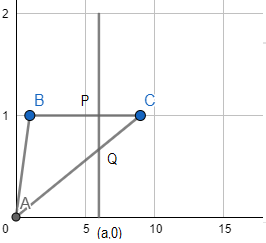
Consider a $\Delta ABC$ in the xy-plane with vertices A = (0,0), B = (1,1) and C = (9,1). If the line x = a divides the triangle into two parts of equal area, then a equals:
(a) 3
(b) 3.5
(c) 4
(d) 4.5
Answer
591k+ views
Hint: Start by drawing the diagrams. Once you draw the diagram, try to find the area of one-half of the two parts and equate it with half of the area of the old triangle.
Complete step-by-step answer:
Now let us start the above question by making the diagram.

For triangle ABC, height is 1 unit, and the base BC is equal to 9-1 = 8 units. Therefore, the area of $\Delta ABC$ is equal to:
\[\Delta ABC=\dfrac{1}{2}\times b\times h=\dfrac{1}{2}\times 8\times 1=4\text{ uni}{{\text{t}}^{2}}\]
Now for the new triangle formed due to the line x=a is $\Delta PQC$ whose base PC is equal to 9-a. Now to find the height PQ, we need to find the point Q.
So, we let the equation of the line AC be $y=\left( \dfrac{{{y}_{2}}-{{y}_{1}}}{{{x}_{2}}-{{x}_{1}}} \right)x$ . Which is:
$y=\dfrac{1}{9}x...........(i)$
Now, when x=a as in case of point q we get $y=\dfrac{1}{9}a$ . Therefore, point Q is $\left( a,\dfrac{1}{9}a \right)$ .
So, we can say that the height of $\Delta PQC$ is PQ which is equal to $1-\dfrac{1}{9}a$ . Therefore, the area of $\Delta PQC$ is:
\[ar\left( \Delta PQC \right)=\dfrac{1}{2}\times b\times h=\dfrac{1}{2}\times \left( 1-\dfrac{1}{9}a \right)\times \left( 9-a \right)uni{{t}^{2}}=\dfrac{{{\left( 9-a \right)}^{2}}}{18}\]
It is given in the question that $\Delta PQC$ should have half the area of $\Delta ABC$ . Using this, we get
$\dfrac{{{\left( 9-a \right)}^{2}}}{18}=\dfrac{1}{2}\times 4$
$\Rightarrow {{\left( 9-a \right)}^{2}}=36$
$\Rightarrow \left( 9-a \right)=6$
$\Rightarrow a=3$
Therefore, the answer to the above question is option (a).
Note: Remember that you could have used the condition of equal parts by equating the area of $\Delta PQC$ and the other quadrilateral that is formed but for this you need to find the area of the quadrilateral, which is a complex task, so, we avoided it in the above solution.
Complete step-by-step answer:
Now let us start the above question by making the diagram.

For triangle ABC, height is 1 unit, and the base BC is equal to 9-1 = 8 units. Therefore, the area of $\Delta ABC$ is equal to:
\[\Delta ABC=\dfrac{1}{2}\times b\times h=\dfrac{1}{2}\times 8\times 1=4\text{ uni}{{\text{t}}^{2}}\]
Now for the new triangle formed due to the line x=a is $\Delta PQC$ whose base PC is equal to 9-a. Now to find the height PQ, we need to find the point Q.
So, we let the equation of the line AC be $y=\left( \dfrac{{{y}_{2}}-{{y}_{1}}}{{{x}_{2}}-{{x}_{1}}} \right)x$ . Which is:
$y=\dfrac{1}{9}x...........(i)$
Now, when x=a as in case of point q we get $y=\dfrac{1}{9}a$ . Therefore, point Q is $\left( a,\dfrac{1}{9}a \right)$ .
So, we can say that the height of $\Delta PQC$ is PQ which is equal to $1-\dfrac{1}{9}a$ . Therefore, the area of $\Delta PQC$ is:
\[ar\left( \Delta PQC \right)=\dfrac{1}{2}\times b\times h=\dfrac{1}{2}\times \left( 1-\dfrac{1}{9}a \right)\times \left( 9-a \right)uni{{t}^{2}}=\dfrac{{{\left( 9-a \right)}^{2}}}{18}\]
It is given in the question that $\Delta PQC$ should have half the area of $\Delta ABC$ . Using this, we get
$\dfrac{{{\left( 9-a \right)}^{2}}}{18}=\dfrac{1}{2}\times 4$
$\Rightarrow {{\left( 9-a \right)}^{2}}=36$
$\Rightarrow \left( 9-a \right)=6$
$\Rightarrow a=3$
Therefore, the answer to the above question is option (a).
Note: Remember that you could have used the condition of equal parts by equating the area of $\Delta PQC$ and the other quadrilateral that is formed but for this you need to find the area of the quadrilateral, which is a complex task, so, we avoided it in the above solution.
Recently Updated Pages
Master Class 12 Business Studies: Engaging Questions & Answers for Success

Master Class 12 Economics: Engaging Questions & Answers for Success

Master Class 12 English: Engaging Questions & Answers for Success

Master Class 12 Maths: Engaging Questions & Answers for Success

Master Class 12 Social Science: Engaging Questions & Answers for Success

Master Class 12 Chemistry: Engaging Questions & Answers for Success

Trending doubts
What is meant by exothermic and endothermic reactions class 11 chemistry CBSE

Which animal has three hearts class 11 biology CBSE

10 examples of friction in our daily life

One Metric ton is equal to kg A 10000 B 1000 C 100 class 11 physics CBSE

1 Quintal is equal to a 110 kg b 10 kg c 100kg d 1000 class 11 physics CBSE

Difference Between Prokaryotic Cells and Eukaryotic Cells




